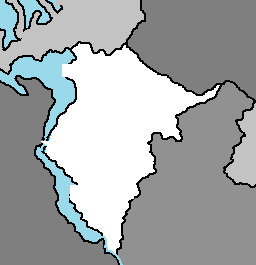Salubar
Confederacy of Salubar Sal-Ubar Bahander | |
|---|---|
|
Flag | |
 | |
| Capital | Dhariwa |
| Largest | Barisad |
| Official languages | Duayya |
| Religion | Islam (69%) Buddhism (20%) Hinduism (13%) Christianity (9%) |
| Population | |
• Estimate | 34,422,000 |
The Confederacy of Salubar, commonly known as Salubar and formerly known as Sal-Ubar or Bahander, is a nation in central Ausiana bordered by Haduastan, Joraistan, Vulkaria, and Rumaztria, with a small coast on the Arasban Inlet which gives it access to the Brau Sea. It has a population of 34,422,000. Dhariwa is the capital and third largest cities, and the port of Mavli along the inlet is the nation's most populous city with more than 5 million inhabitants. The second-most populous city is the northern port city of Barisad, which has 2 million inhabitants. Garaht, the fourth-largest city, is located near the Vulkarian border.
The Salu peoples migrated from central Ausiana to the area now known as Salubar from the 11th century. It was ruled by Hadua kingdoms for hundreds of years. Euronian contact began in 1311 with a Drambenburgian diplomatic mission to Bahander, which became a regional power by the end of the 14th century. Bahander was eventually colonized by Drambenburg, which expanded its colonial control throughout the region in 1602. Drambenburgian companies took advantage of textile and agricultural industries in Salubar, turning it into an important commercial hub rivaling ports in Haduastan. When the World War rolled through the region in 1950, Drambenburgian forces in Salubar were able to maintain control of their colony, even as they lost territory throughout the rest of their empire. When Drambenburg surrendered at the end of the war, Salubar was one of the few overseas holdings that was maintained as part of the empire. In 1957, an independence movement within Salubar swept the nation, and Drambenburgian forces fought an 8-year long war to try and maintain the colony. In 1965, Drambenburgian forces withdrew from Salubar, and the revolutionary leader Prayut Hao Bastin became the first president. However, Hao Bastin was overthrown in 1971 in a military coup. Apart from a brief period of parliamentary democracy in the mid-1980s, Salubar has periodically alternated between democracy and military rule. Since the 2000s the country has been caught in continual bitter political conflict between supporters and opponents of Bahina Syina, which resulted in two coups (in 2004 and 2011), along with the establishment of its current constitution, a nominally democratic government after the 2018 elections, and large pro-democracy protests in 2020–2021 which included unprecedented demands to reform the constitution.
Salubar is classified as a newly industrialised economy, with manufacturing, agriculture, and tourism as leading sectors.
